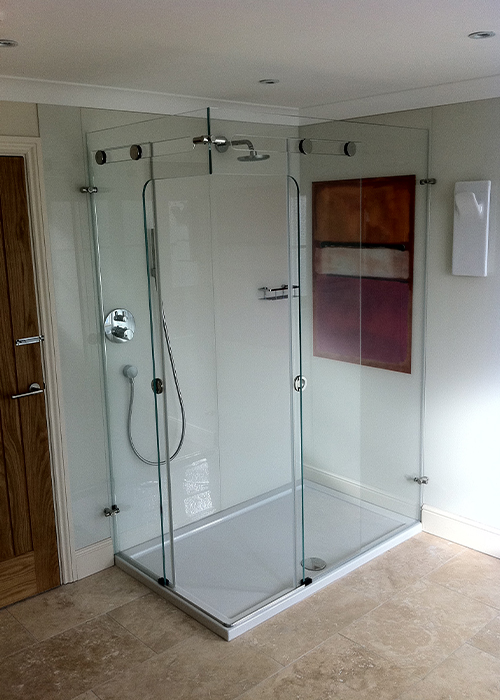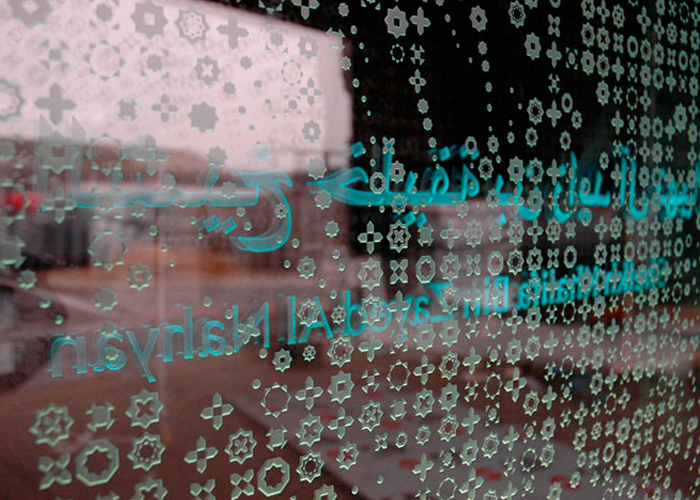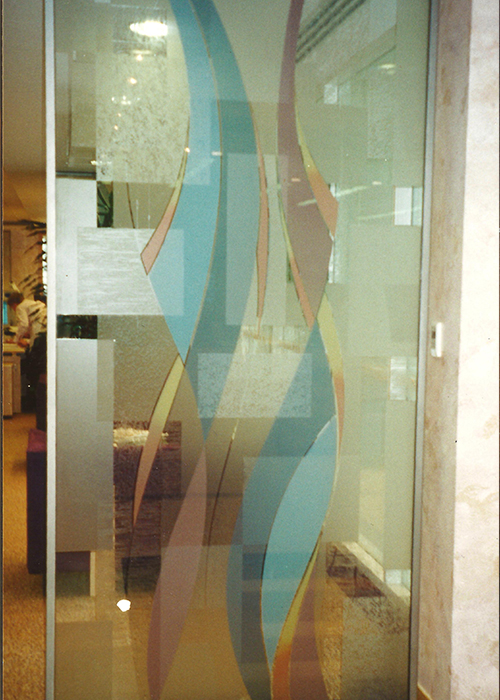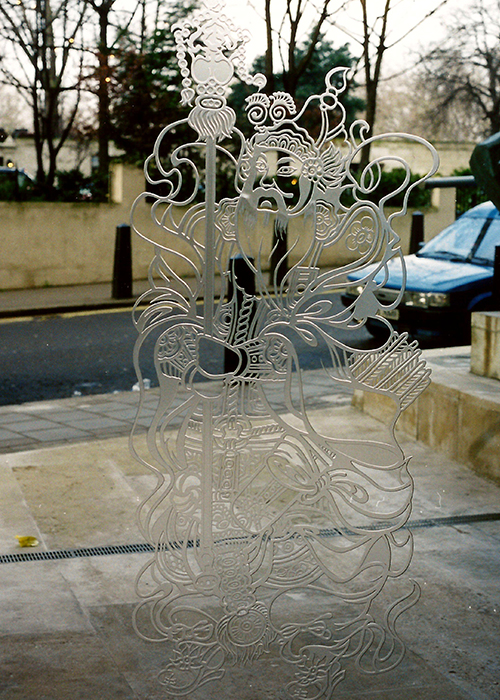SANDBLASTING / FROSTING
Intricate designs and textures for visual impact
With sandblasting we can create intricate patterns and design, carving into surface of the glass.
We first create a stencil, or handcut the design or pattern onto a resist. The surface of the glass can then be etched by hand, creating a beautiful tactile effect.
Sandblasting is an ideal way to create glass signage, or introduce different tones and textures into opaque areas for privacy, such as obscured glass windows or screens.
Kiln Form
Moulded and shaped to your design
Originally developed in Australia, this technique creates glass that dances with the light as it refracts and changes, depending on movement and perspective within your space.
We create a unique mould or pattern to suit your design and site.
The glass is then slumped in a kiln, which can reach temperatures up to 800 degrees. Once the cycle is complete, the glass will have slumped over the design to create the desired effect.
Mark Rogerson Glass has used the kiln form technique to create commemorative bowls for SBS TV, and replicate the Magna Carta for the Supreme Court in London UK, as well as for contemporary office partitions and garden landscape sculptures.
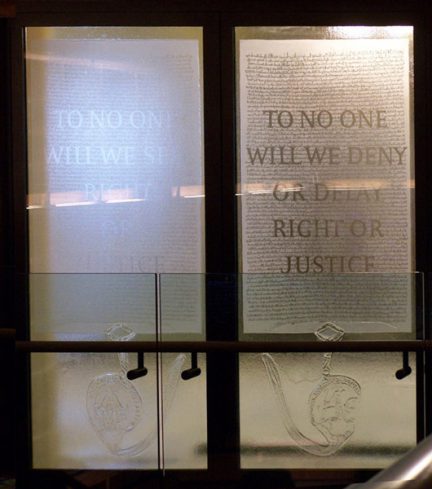
Bonding
Stunning and contemporary stained glass technique
Traditionally, a stained glass window is held together with lead, but with this relatively new technique we can bond coloured glass pieces together, removing the harsh black lead lines around each piece.
This creates a beautiful flow of colour, as each piece is precisely cut and laid seamlessly alongside each other. Without the normal constraints of lead light we can use mouth-blown glass to add vibrant colour to your window or door panels.
Bonding complements other glass design techniques such as sandblasting and acid etching. At Mark Rogerson Glass, our cutting-edge bonding expertise includes corporate offices, churches, mosques and temples around the world.
Gilding
Luxury finishes in glass
This historic craft applies gold leaf to glass, creating spectacular design finishes.
We apply wafer thin sheets of gold (typically 22 carat, unless specified otherwise) to the surface of the glass.
At Mark Rogerson Glass, we can also use other precious metals in this process, including silver, copper and bronze to add a dimension or aesthetic.
We usually etch the gilded area first, so the gold leaf will adhere to the surface. Layer upon layer of leaf is then carefully applied by hand, to create a solid block of gold.
Gilding can be used to great effect in minimal quantities, and often works well with complementary design techniques such as acid etching.
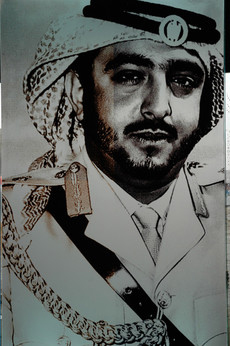
Film / Vinyl
Cost-effective custom glass designs
Applying film or vinyl to glass is a quick and affordable alternative to sandblast and acid etched technique.
If you’d like to create privacy with opaque windows or panels, or add a custom design such as a company logo, branding, photography or repetitive pattern, we can use decorative window film and vinyl to achieve the impact you need on glass.
If you can imagine it, we can impose that image onto film.
It is also ideal for functional glass designs, such as safety strips.
Acid Etching
Detailed patterns and complex designs in glass
If your design is intricate and requires different tonal shades, or precision within a monochrome pattern, acid etching uses hydrofloric acid to etch into the surface of the glass.
Also known as French Embossing, it requires specialist resists and micas to create spectacular detail. It is a particularly eye-catching glass design technique for business logos and signage, patterned partitions or obscured windows.
Mark Rogerson used this technique to create the heraldic coats of arms for Buckingham Palace.
Sandblasting / Frosting
Intricate designs and textures for visual impact
With sandblasting we can create intricate patterns and design, carving into surface of the glass.
We first create a stencil, or handcut the design or pattern onto a resist. The surface of the glass can then be etched by hand, creating a beautiful tactile effect.
Sandblasting is an ideal way to create glass signage, or introduce different tones and textures into opaque areas for privacy, such as obscured glass windows or screens.
Kiln Form
Moulded and shaped to your design
Originally developed in Australia, this technique creates glass that dances with the light as it refracts and changes, depending on movement and perspective within your space.
We create a unique mould or pattern to suit your design and site.
The glass is then slumped in a kiln, which can reach temperatures up to 800 degrees. Once the cycle is complete, the glass will have slumped over the design to create the desired effect.
Mark Rogerson Glass has used the kiln form technique to create commemorative bowls for SBS TV, and replicate the Magna Carta for the Supreme Court in London UK, as well as for contemporary office partitions and garden landscape sculptures.

Bonding
Stunning and contemporary stained glass technique
Traditionally, a stained glass window is held together with lead, but with this relatively new technique we can bond coloured glass pieces together, removing the harsh black lead lines around each piece.
This creates a beautiful flow of colour, as each piece is precisely cut and laid seamlessly alongside each other. Without the normal constraints of lead light we can use mouth-blown glass to add vibrant colour to your window or door panels.
Bonding complements other glass design techniques such as sandblasting and acid etching. At Mark Rogerson Glass, our cutting-edge bonding expertise includes corporate offices, churches, mosques and temples around the world.
Gilding
Luxury finishes in glass
This historic craft applies gold leaf to glass, creating spectacular design finishes.
We apply wafer thin sheets of gold (typically 22 carat, unless specified otherwise) to the surface of the glass.
At Mark Rogerson Glass, we can also use other precious metals in this process, including silver, copper and bronze to add a dimension or aesthetic.
We usually etch the gilded area first, so the gold leaf will adhere to the surface. Layer upon layer of leaf is then carefully applied by hand, to create a solid block of gold.
Gilding can be used to great effect in minimal quantities, and often works well with complementary design techniques such as acid etching.
Film / Vinyl
Cost-effective custom glass designs
Applying film or vinyl to glass is a quick and affordable alternative to sandblast and acid etched technique.
If you’d like to create privacy with opaque windows or panels, or add a custom design such as a company logo, branding, photography or repetitive pattern, we can use decorative window film and vinyl to achieve the impact you need on glass.
If you can imagine it, we can impose that image onto film.
It is also ideal for functional glass designs, such as safety strips.

Acid Etching
Detailed patterns and complex designs in glass
If your design is intricate and requires different tonal shades, or precision within a monochrome pattern, acid etching uses hydrofloric acid to etch into the surface of the glass.
Also known as French Embossing, it requires specialist resists and micas to create spectacular detail. It is a particularly eye-catching glass design technique for business logos and signage, patterned partitions or obscured windows.
Mark Rogerson used this technique to create the heraldic coats of arms for Buckingham Palace.



